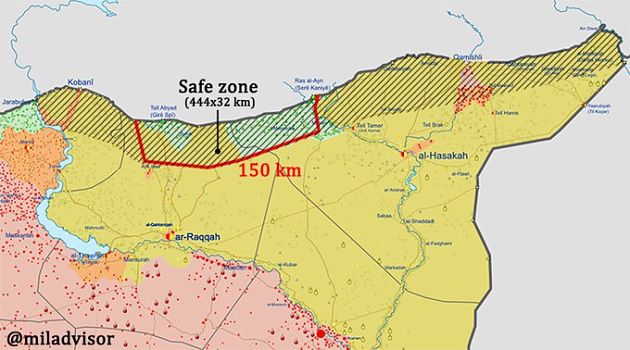The first week of the promising “Fountain of Peace” operation in northeastern Syria has passed, allowing for preliminary conclusions about its results and prospects.
The “Voice of Islam” publishes news about it daily, and most of our readers, of course, also read other media on this topic, so in this case we will not overload the material with details and try to focus on the main points.
Let us remind you that the stated goal of the operation was to create a continuous safe zone 30 kilometers deep inside Syria along the entire perimeter of the part of its border with Turkey controlled by the so-called Syrian Democratic Forces (SDF), the core of which consists of Kurdish communists from the YPG. We are talking about an area about 420 kilometers long and 30 kilometers deep, which would form a continuous territorial array with the previously created safe zones by Turkey and its allies from the Syrian National Army (SNA) as a result of the previous operations “Euphrates Shield” and “Olive Branch”. This would allow for the future resettlement of some three million Syrian refugees from Turkey and, by consolidating these areas and populations under the control of the SNA and the temporary government of Syria, effectively create a mini-state for the Syrian opposition, which would negotiate its relations with Damascus from a position of strength.
What can be said at this point? While the forces of the operation have taken control of about 55 populated areas (the numbers are constantly changing) in an area about 110 kilometers long, their progress looks quite problematic. Why this is happening is a question for a separate analysis, but for now we need to understand what this problem consists of.
The essence of the problem is that simultaneously with the advance of the operational forces on a limited area compared to the declared space, other players have appeared on the rest of its part. Against this background, the position of the Turkish forces and the SNA looks bleak compared to their declared goals, and the situation itself resembles a competition for the division of the former SDF-YPG territory, in which they are losing to the Assad regime. (Green on the map represents the territory seized by Turkey and the SNA, red – by the regime)
Particularly unattractive is the announced establishment of regime control over Manbij, which the Turkish leadership has repeatedly promised to include in its safe zone for many years, as if deliberately giving this city a symbolic importance that is not evident from a practical point of view.
In this situation, there are reasons for pessimistic predictions and assessments, which come down to the fact that by carrying out the operation in such an inefficient way, Turkey intentionally or unintentionally pushed the “Kurds” into the arms of the regime, which effectively took advantage of its mistakes to seize a significant part of the territory that was supposed to go to the Turks and the SNA. More moderate assessments suggest that Turkey may not have initially intended to claim the entire declared territory, but only a part of it in the area between Ras al-Ain and Tell Abyad, as well as the areas north of the Manbij Protrusion, with a total length of about 105 kilometers. Pro-Assad channels are already outlining a rough scheme to divide the initially declared Turkish territory of the safe zone, leaving only a smaller part for them.
However, an important nuance must be taken into account. The control of Turkey and the SNA over the seized areas, although limited in space, is unconditional – it is the complete occupation of the populated areas by the armed forces, i.e. the establishment of full control over them. The regime’s control over most of the seized areas, such as Manbij, is rather conditional and consists mainly of the presence of several military vehicles driving through the populated area with flags and then posting photos and videos on the Internet.
The reasons for this are objective and should be clear from the maps – if the forces of Turkey and the SNA advance massively from their foothold into the adjacent areas, then the Assad forces will be separated by significant distances from many of the areas they claim to control, which will require equally significant forces to occupy.
It is therefore premature to draw definitive conclusions about the results and prospects of this operation. This includes the diplomatic or negotiating component, which is no less important than the military aspect. Yesterday, the Americans seemed to give the green light to Turkey and the SNA to occupy their safe zone from which the “Kurds” should evacuate within 120 hours. They first rejected these conditions, then apparently partially accepted them, and as a result today’s fighting has continued, albeit with less intensity.
In return, Erdogan insists that the length of the safe zone after the operation will be 444 kilometers, not 110 kilometers as it is now. Such an outcome seems realistic only in one case – if Washington and Moscow do not hinder him, as they are doing at the moment. He is engaged in extremely tense negotiations with representatives of the former, accompanied by comical letters and Trump’s tweets. Erdogan’s meeting with Putin is scheduled for October 22 and, according to him, after that peace will be established in Syria.
Well, we just have to wait and see if the promised peace will be established and how big the Turkish protectorate in Syria will be after this meeting.

